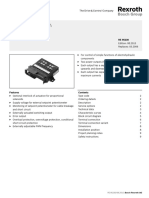High and Low Voltage Cutoff With Delay and Alarm Using 555 Timer
Uploaded by
Surendra SinghHigh and Low Voltage Cutoff With Delay and Alarm Using 555 Timer
Uploaded by
Surendra SinghHIGH AND LOW VOLTAGE CUTOFF WITH DELAY
AND ALARM USING 555 TIMER
A PROJECT REPORT SUBMITTED
for external evaluation of
ELECTRICAL & ELECTRONICS WORKSHOP
Bachelor of Technology
In
Electrical and Electronics Engineering
By
Name of Student Registration No:
Surendra Prasad Singh 1641014181
2ND Semester, EEE (C)
DEPARTMENT OF ELECTRICAL AND ELECTRONICS ENGINEERING
Institute of Technical Education and Research
SIKSHA ‘O’ ANUSANDHAN UNIVERSITY
Bhubaneswar, Odisha, India
(April, 2017)
[i]
ACKNOWLEDGEMENT
I would like to take this opportunity to express our gratitude to our respected mentors
Prof. Jyoti Ranjan Padhi Mr. Bibekananda Jena, for the inspired guidance, insight, continuous
encouragement, timely suggestions that they have provided throughout the duration of this
work. The present work, being successfully completed due to their sincere monitoring and vital
inputs.
We are grateful to Prof. Niranjan Nayak, Head of the Department of Electrical and Electronics
Engineering, and Prof. Guru Prasad Mishra, Head of the Department of Electronics and
Communication Engineering, permitted us to make use of the available facilities in the
department to carry out the project successfully.
We would also thank all our staff members, especially Mr. Hemanta Kumar Swain, Mr. Indu
Sekhar Samanta, Mr. Adikanda Mishra, friends, and faculty of Department of Electrical
Engineering and Electronics & Communication Engineering for their support and all kinds of
help to accomplish this work.
Signature of the Student
(Name and Registration No.)
[ii]
DECLARATION
I declared that
a. The work contained in this report is original and has been done by me.
b. I have followed the guidelines provided by the Department in preparing the report.
c. I have followed the professional and ethical responsibility provided by the university.
Signature of the students Registration No.:
Date: ____________________
[iii]
ABSTRACT
In Electronics, cut-off voltage is a voltage at which battery is considered fully discharged,
beyond which further discharge could cause harm. Here the cut-off voltage is prescribed as
lower limit voltage. The cut-off voltage is chosen so that the maximum useful capacity of the
battery is achieved.
High voltage and low voltage cut-off delay is an instrument that helps to protect various
home appliances when the normal AC voltage supplied is too high and it even indicate when
the AC supply voltage is low . If the supplied voltage is abnormal (High or Low) then the
circuit automatically turns of the load. It also produces sound when main power resumes.
This straight forward circuit will protect electrical appliances from over voltage as well as
under voltage. This circuit also produces an alarm when the power supply comes back. An
ideal circuit for home to protect your valuable equipments from voltage fluctuations. The
same circuit with some modifications can be used to make a automatic voltage stabilizer.
[iv]
TABLE OF CONTENTS
Sr. No. Content Page No. Remarks
1. Acknowledgement ii
2. Declaration iii
3. Abstract iv
4. Table Of Contents v
5. List Of Tables vi
6. List Of Figures vii
7. List Of Symbols viii
8. Chapter 1 ix
9. Chapter 2 x-xi
10. Chapter 3 xii-xiii
11. Chapter 4 xiv
12. Chapter 5 xv-xxii
13. Chapter 6 xxiii-xxix
14. Chapter 7 xxx
15. Chapter 8 xxxi
16. Chapter 9 xxxii-xxxiii
17. Chapter 10 xxxiv
18. Chapter 11 xxxv
19. Chapter 12 xxxvi
[v]
LIST OF TABLES
Table Table Caption Page No.
No.
2.1 Questionnaire of the Product x,xi
4.1 Components user and their specification. xiv
5.1 Pin Configuration xvi
[vi]
LIST OF FIGURES
Figure No. Page No.
3.1 xiv
5.1 xvi
5.2 xviii
5.3 xix
5.4 xxi
5.5 xxiii
6.1 xxvi
6.2 xxix
9.1 xxxiii
9.2 xxxiv
[vii]
LIST OF SYMBOLS
KΩ:- Kilo Ohm for resistor.
µF:- Micro Farad for capacitor.
Hz:- Hertz for Frequency.
MHz:- Mega Hertz
V:- Volt
mF:- micro Farad
[viii]
Chapter 1
Introduction:
Generally voltage stabilizers are used in this type of applications to maintain constant AC
Voltage. However due to the abnormal AC supply, relays in voltage stabilizer switches ON
and OFF continuously. The frequent energization or de-energization of relays leads to the
shortening the life time of appliances and the stabilizer itself. Hence it is better to use this
project in order to control the appliances instead of costly stabilizers.
Circuit Description
When supply voltage is high, the DC voltage at the cathode of zener diode D4 becomes
greater than 5.6V. As a result, transistor Q1 is in ON and transistor Q2 gets switched off.
Hence the relay RL1 de-energizes and load would be in OFF condition.
Under low supply voltage condition, transistor Q1 switches to ON condition and as a
result transistor Q2 switches off, making the load OFF.
When normal AC supply voltage is applied, the DC voltage at the cathode of zener diode D4
is less than 5.6V, now transistor Q1 is off condition. As a result, transistor Q2 is in ON
condition, hence load switches to ON by indicating the green LED.
When supply is resumed after a break, 555 timer IC goes low and this triggers the 555 timer
IC. The output of 555 timer IC makes sound IC to operate through the transistor Q3, at the
same time, transistor Q1 switches to ON condition as the output 555 timer is connected to the
base of Q1 and results transistor Q2 OFF. Thus the relay switches off the load.
In this circuit, 555 timer is configured to operate in monostable mode. In this circuit, pin4 and
pin8 are shorted to avoid sudden resets. The pulse width of the 555 timer output signal is
about 10 seconds. This output signal drives the speaker.
Speaker gives melodious sound when power is resumed because of UM66 IC. The volume of
the speaker can be controlled by using POT RV3.
Green LED indicates normal AC supply voltage. Red LED is used for power indication.
Here zener diode D4 along with transistor Q1 is used for comparing the input voltage.
Transistor Q2 switches the load based on the output of transistor Q1. Diodes D1 and D2 are
used for rectification purpose. Capacitor C1 filters the input AC ripples.
[ix]
Chapter 2
Customer Needs Recognition:
2.1 Questionnaire method
Table 2.1: Questionnaire for the product
Qns Descriptions
No.
Q.1 Question: Is the voltage stabilizer helping you in daily life?
(a) Agree
(b) Strongly Agree
(c) Disagree
(d) Strongly Disagree
Q.2 Question: Is it easy to carry everywhere?
(a) Agree
(b) Strongly Agree
(c) Disagree
(d) Strongly Disagree
Q.3 Question: Is it working well in 230V ac mains?
(a) Agree
(b) Strongly Agree
(c) Disagree
(d) Strongly Disagree
Q.4 Question: Do you feel that the product is heavy to carry?
(a) Agree
(b) Strongly Agree
(c) Disagree
(d) Strongly Disagree
Q.5 Question: Is it helping in generating fixed as well as variable voltages?
(a) Agree
(b) Strongly Agree
(c) Disagree
(d) Strongly Disagree
Q.6 Question: Is it harmful for the society?
(a) Agree
(b) Strongly Agree
(c) Disagree
(d) Strongly Disagree
Q.7 Question: Does the product have any problem in functioning?
(a) Agree
(b) Strongly Agree
[x]
(c) Disagree
(d) Strongly Disagree
Q.8 Question: Do you think the product is compactable, or need further improvement?
(a) Agree
(b) Strongly Agree
(c) Disagree
(d) Strongly Disagree
Q.9 Question: Do you think the product is cost effective?
(a) Agree
(b) Strongly Agree
(c) Disagree
(d) Strongly Disagree
Q.10 Question: Is it perfectly detecting all types of signals?
(a) Agree
(b) Strongly Agree
(c) Disagree
(d) Strongly Disagree
2.2 Problem statement with requirements and constraints
1. To make the students self-dependent.
2. This circuit is simple and user friendly. It reduces the complicacy of using the huge machines.
3. I am making it little compactable having low cost , less weight and less complexity helping
students to be independent.
[xi]
CHAPTER-3
Product Function Decomposition:-
RELAY LOAD
SL100
12-0-12 (T2) T2 LED 1
AC
SUPPLY
555
TIMER
T3 LED 2
T3 UM66
T4
BUZZER
[xii]
CIRCUIT DIAGRAM
Fig 3.1
[xiii]
Chapter 4
Benchmarking and Engineering Specification:-
4.1:Components used and their specification.
Component Specification
1.Transistor SL100
2.Capacitor i. 0.1 μF
ii. 0.01 μF
iii. 10 μF 16 V
iv. 100 μF 16 V
3.Integrated Circuit i. NE555P
ii. UM66T
4.Resistor i. 1 kΩ
ii. 100 kΩ
iii. 10 kΩ
iv. 1 MΩ
5.Diode 1N4148, IN4007
6.Potentiometer 5 kΩ , 10 kΩ
7.Connecting wires Single Strand(23 SWG)
8.LED Generic(Blue , Red)
[xiv]
Chapter 5
Product Architecture:
1.NE555P : The 555 timer IC is an integrated circuit (chip) used in a variety of timer,
pulse generation, and oscillator applications. The 555 can be used to provide time delays, as
an oscillator, and as a flip-flop element. Derivatives provide two or four timing circuits in one
package.
Depending on the manufacturer, the standard 555 package includes 25 transistors,
2 diodes and 15 resistors on a silicon chip installed in an 8-pin mini dual-in-line package
(DIP-8). Variants available include the 556 (a 14-pin DIP combining two 555s on one chip),
and the two 558 & 559s (both a 16-pin DIP combining four slightly modified 555s with DIS
& THR connected internally, and TR is falling edge sensitive instead of level sensitive).
The NE555 parts were commercial temperature range, 0 °C to +70 °C, and the SE555 part
number designated the military temperature range, −55 °C to +125 °C. These were available
in both high-reliability metal can (T package) and inexpensive epoxy plastic (V package)
packages. Thus the full part numbers were NE555V, NE555T, SE555V, and SE555T. It has
been hypothesized that the 555 got its name from the three 5 kΩ resistors used within but
Hans Camenzind has stated that the number was arbitrary.[3]
Low-power versions of the 555 are also available, such as the 7555 and CMOS TLC555. The
7555 is designed to cause less supply noise than the classic 555 and the manufacturer claims
that it usually does not require a "control" capacitor and in many cases does not require
a decoupling capacitor on the power supply. Those parts should generally be included,
however, because noise produced by the timer or variation in power supply voltage might
interfere with other parts of a circuit or influence its threshold voltages.
Fig 5.01
[xv]
5.1:The connection of the pins for a DIP package is as follows:
Pin Name Purpose
1 GND Ground reference voltage, low level (0 V)
The OUT pin goes high and a timing interval starts when this input falls below
1/2 of CTRL voltage (which is typically 1/3 VCC, CTRL being 2/3 VCC by default if
2 TRIG CTRL is left open). More simply we can say that OUT will be high as long as
the trigger is kept at low voltage. Output of the timer totally depends upon the
amplitude of the external trigger voltage applied to this pin.
3 OUT This output is driven to approximately 1.7 V below +VCC, or to GND.
A timing interval may be reset by driving this input to GND, but the timing does
4 RESET not begin again until RESET rises above approximately 0.7 volts. Overrides
TRIG which overrides THR.
5 CTRL Provides "control" access to the internal voltage divider (by default, 2/3 VCC).
The timing (OUT high) interval ends when the voltage at THR ("threshold") is
6 THR
greater than that at CTRL (2/3 VCC if CTRL is open).
Open collector output which may discharge a capacitor between intervals. In
7 DIS
phase with output.
Positive supply voltage, which is usually between 3 and 15 V depending on the
8 VCC
variation.
Modes
The IC 555 has three operating modes:
A )Bistable mode or Schmitt trigger – the 555 can operate as a flip-flop, if the DIS pin is
not connected and no capacitor is used. Uses include bounce-free latched switches.
B )Monostable mode – in this mode, the 555 functions as a "one-shot" pulse generator.
Applications include timers, missing pulse detection, bounce-free switches, touch
[xvi]
switches, frequency divider, capacitance measurement, pulse-width modulation (PWM)
and so on.
C )Astable (free-running) mode – the 555 can operate as an electronic oscillator. Uses
include LED and lamp flashers, pulse generation, logic clocks, tone generation, security
alarms, pulse position modulation and so on. The 555 can be used as a simple ADC,
converting an analog value to a pulse length (e.g., selecting a thermistor as timing resistor
allows the use of the 555 in a temperature sensor and the period of the output pulse is
determined by the temperature). The use of a microprocessor-based circuit can then
convert the pulse period to temperature, linearize it and even provide calibration means.
2.Resistor: A resistor is a passive two-terminal electrical component that
implements electrical resistance as a circuit element. In electronic circuits, resistors are used
to reduce current flow, adjust signal levels, to divide voltages, bias active elements, and
terminate transmission lines, among other uses. High-power resistors that can dissipate
many watts of electrical power as heat may be used as part of motor controls, in power
distribution systems, or as test loads for generators. Fixed resistors have resistances that only
change slightly with temperature, time or operating voltage. Variable resistors can be used to
adjust circuit elements (such as a volume control or a lamp dimmer), or as sensing devices for
heat, light, humidity, force, or chemical activity.
Resistors are common elements of electrical networks and electronic circuits and are
ubiquitous in electronic equipment. Practical resistors as discrete components can be
composed of various compounds and forms. Resistors are also implemented within integrated
circuits.
The electrical function of a resistor is specified by its resistance: common commercial
resistors are manufactured over a range of more than nine orders of magnitude. The nominal
value of the resistance falls within the manufacturing tolerance, indicated on the component.
Fig 5.2
[xvii]
fig 5.3
3.CAPACITOR: A capacitor is a passive two-terminal electrical component that stores
electrical energy in an electric field. The effect of a capacitor is known as capacitance. While
capacitance exists between any two electrical conductors of a circuit in sufficiently close
proximity, a capacitor is specifically designed to provide and enhance this effect for a variety
of practical applications by consideration of size, shape, and positioning of closely spaced
conductors, and the intervening dielectric material. A capacitor was therefore historically first
known as an electric condenser.
The physical form and construction of practical capacitors vary widely and many capacitor
types are in common use. Most capacitors contain at least two electrical conductors often in
the form of metallic plates or surfaces separated by a dielectric medium. A conductor may be
a foil, thin film, sintered bead of metal, or an electrolyte. The nonconducting dielectric acts to
increase the capacitor's charge capacity. Materials commonly used as dielectrics
include glass, ceramic, plastic film, paper, mica, and oxide layers. Capacitors are widely used
as parts of electrical circuits in many common electrical devices. Unlike a resistor, an ideal
capacitor does not dissipate energy.
When two conductors experience a potential difference, for example, when a capacitor is
attached across a battery, an electric field develops across the dielectric, causing a net
positive charge to collect on one plate and net negative charge to collect on the other plate.
No current actually flows through the dielectric, however, there is a flow of charge through
the source circuit. If the condition is maintained sufficiently long, the current through the
source circuit ceases. However, if a time-varying voltage is applied across the leads of the
capacitor, the source experiences an ongoing current due to the charging and discharging
cycles of the capacitor.
[xviii]
Capacitance is defined as the ratio of the electric charge on each conductor to the potential
difference between them. The unit of capacitance in the International System of Units (SI) is
the farad (F), defined as one coulomb per volt (1 C/V). Capacitance values of typical
capacitors for use in general electronics range from about 1 pF (10−12 F) to about 1 mF
(10−3 F).
The capacitance of a capacitor is proportional to the surface area of the plates (conductors)
and inversely related to the gap between them. In practice, the dielectric between the plates
passes a small amount of leakage current. It has an electric field strength limit, known as
the breakdown voltage. The conductors and leads introduce an
undesired inductance and resistance.
Capacitors are widely used in electronic circuits for blocking direct current while
allowing alternating current to pass. In analog filter networks, they smooth the output
of power supplies. In resonant circuits they tune radios to particular frequencies. In electric
power transmission systems, they stabilize voltage and power flow. The property of energy
storage in capacitors was exploited as dynamic memory in early digital computers.
4.SL100 TRANSISTOR: Transistors are the basic building blocks of integrated (IC).
Every electronic gadget you can possibly imagine today uses transistors. The development
started off with vacuum tubes and lead to the transistor as the BJT we see today. A bipolar
junction transistor (BJT) is a type of transistor that uses both electron and hole as charge
carriers. BJTs can be classified into two types, NPN and PNP transistors. An NPN transistor
consists of layer of p-doped semiconductor between two n-doped layers. Whereas a PNP
transistor consists of n-doped semiconductor between two p-doped layers. The most common
example in usage being the SL100 transistor.
Sl100 transistor is a general purpose, medium power NPN transistor. Being a general purpose
transistor makes the SL100 transistor open to a wide spectrum of electronic applications. Major
applications range from general switching, manufacture of logic gates, amplification and sound
[xix]
reproduction, radio transmission and signal processing. However, it’s generally used as a
switch in common emitter configuration.
The transistor terminals require a fixed DC voltage to operate in the desired region of its
characteristic curves. This is known as the biasing. SL100 transistor is biased to remain fully
ON if there is a signal at its base. It is turned OFF completely in the absence of base signal.
Depending on the transistor biasing and the circuits connected to it, the transistor acts either as
an amplifier or as a switch. When acting as an amplifier, the transistor can transmit or receive
radio signals, perform analog mathematical calculations, generate wave-forms among other
functions. When acting as a switch the circuit can turn on/off a light, motor, perform digital
logic or mathematical operations, fetch and decode computer instructions and the like. The pin
diagram of a typical SL100 transistor is given below.
fig 5.4
Pin Diagram of SL100 transistor
A SL100 transistor has 3 terminals namely a collector, a base and an emitter. A protruding edge
in the transistor case indicates the emitter. The base is nearest to the emitter while collector lies
at the other extreme of the casing.
The datasheet for SL100 transistor is available at SL100 transistor datasheet.
[xx]
SL100 transistor is very cheap and readily available in market, which fetches them wide range
of applications in various circuits. A SL100 transistor is sufficient enough to construct a simple
continuity tester circuit, which gives visual and audio outputs when the continuity present at
the probes. Other circuits using SL100 transistors are automated water level indicator, rain
detector alarm circuit. Automatic street light circuit, automatic emergency lights, beeper
circuit, gas sensor alarm circuit, automatic voltage stabilizer, solar charger are also some
applications.
5.1N4148 diode: The 1N4148 is a standard silicon switching signal diode. It is one of the
most popular and long-lived switching diodes because of its dependable specifications and
low cost. Its name follows the JEDEC nomenclature. The 1N4148 is useful in switching
applications up to about 100 MHz with a reverse-recovery time of no more than 4 ns.
The 1N4148 comes in a DO-35 glass package for through-hole mounting, which is useful
for bread boarding of circuits. Surface mount devices are available: LL4148 in Mini
MELF package,1N4148W in SOD-123 package, 1N4148WS in SOD-323 package,1N4148X
in SOD-523 package. Some surface mount packages are marked with "T4" text.
As the most common mass-produced switching diode, the 1N4148 replaced the older 1N914.
They differ mainly in their leakage current specification at 25°C: 25 nA @ -20V vs. 5 µA
75V.with maximum leakage for both at 150°C to be 50 µA @ -20V. Today manufacturers
produce the 1N4148 and sell it as either part number. It was second-sourced by many
manufacturers; Texas Instruments listed their version of the device in an October 1966 data
sheet. These device types have an enduring popularity in low-current applications.
[xxi]
6.UM66 IC: UM66T is a melody integrated circuit. It is designed for use in bells, telephones,
toys etc. It has an inbuilt tone and a beat generator. The tone generator is a programmed divider
which produces certain frequencies. These frequencies are a factor of the oscillator frequency.
The beat generator is also a programmed divider which contains 15 available beats. Four beats
of these can be selected.
There is an inbuilt oscillator circuit that serves as a time base for beat and tone generator. It has
a 62 notes ROM to play music. A set of 4 bits controls the scale code while 2 bits control the
rhythm code. When power is turned on, the melody generator is reset and melody begins from
the first note. The speaker can be driven by an external npn transistor connected to the output
of UM66.
Many versions of UM66T are available which generate tone of different songs. For example,
UM66T01 generates tone for songs ‘Jingle bells’, ‘Santa Claus is coming to town’ and ‘We
wish you a merry X’mas’.
Pin Diagram:
fig 5.5
Pin Description:
Pin No Function Name
1 Melody output Output
2 Supply voltage (1.5V - 4.5V) Vcc
3 Ground (0V) Ground
[xxii]
Chapter 6
Analytical and Numerical Model Solutions:
THEORY OF OPERATION:-
Ohm's law
The behaviour of an ideal resistor is dictated by the relationship specified by Ohm's law:
Ohm's law states that the voltage (V) across a resistor is proportional to the current (I),
where the constant of proportionality is the resistance (R). For example, if a
300 ohm resistor is attached across the terminals of a 12 volt battery, then a current of 12
/ 300 = 0.04 amperes flows through that resistor.
Practical resistors also have some inductance and capacitance which affect the relation
between voltage and current in alternating current circuits.
The ohm (symbol: Ω) is the SI unit of electrical resistance, named after Georg Simon
Ohm. An ohm is equivalent to a volt per ampere. Since resistors are specified and
manufactured over a very large range of values, the derived units of milliohm (1 mΩ =
10−3 Ω), kilohm (1 kΩ = 103 Ω), and megohm (1 MΩ = 106 Ω) are also in common usage.
Series and parallel resistors
The total resistance of resistors connected in series is the sum of their individual
resistance values.
The total resistance of resistors connected in parallel is the reciprocal of the sum
of the reciprocals of the individual resistors.
[xxiii]
For example, a 10 ohm resistor connected in parallel with a 5 ohm
resistor and a 15 ohm resistor produces 1/1/10 + 1/5 + 1/15 ohms of
resistance, or 30/11 = 2.727 ohms.
A resistor network that is a combination of parallel and series
connections can be broken up into smaller parts that are either one or the
other. Some complex networks of resistors cannot be resolved in this
manner, requiring more sophisticated circuit analysis. Generally, the Y-Δ
transform, or matrix methods can be used to solve such problems.
Power dissipation
The power P dissipated by a resistor (or the equivalent resistance of a resistor network)
is calculated as:
The first form is a restatement of Joule's first law. Using Ohm's law, the two other forms
can be derived.
The total amount of heat energy released over a period of time can be determined from
the integral of the power over that period of time:
Practical resistors are rated according to their maximum power dissipation. The vast majority
of resistors used in electronic circuits absorb much less than a watt of electrical power and
require no attention to their power rating. Such resistors in their discrete form, including most
of the packages detailed below, are typically rated as 1/10, 1/8, or 1/4 watt.
Resistors required to dissipate substantial amounts of power, particularly used in power
supplies, power conversion circuits, and power amplifiers, are generally referred to as power
resistors; this designation is loosely applied to resistors with power ratings of 1 watt or greater.
Power resistors are physically larger and tend not to use the preferred values, color codes, and
external packages described below.
If the average power dissipated by a resistor is more than its power rating, damage to the resistor
may occur, permanently altering its resistance; this is distinct from the reversible change in
resistance due to its temperature coefficient when it warms. Excessive power dissipation may
raise the temperature of the resistor to a point where it can burn the circuit board or adjacent
components, or even cause a fire. There are flameproof resistors that fail (open circuit) before
they overheat dangerously.
Capacitors
The capacitor is a reasonably general model for electric fields within electric circuits.
An ideal capacitor is wholly characterized by a constant capacitance C, defined as the ratio of
charge ±Q on each conductor to the voltage V between them:
[xxiv]
Sometimes charge build-up affects the capacitor mechanically, causing its capacitance
to vary. In this case, capacitance is defined in terms of incremental changes:
Fig. 6.1
ENERGY STORAGE:
Work must be done by an external influence to "move" charge between the conductors
in a capacitor. When the external influence is removed the charge separation persists in the
electric field and energy is stored to be released when the charge is allowed to return to
its equilibrium position. The work done in establishing the electric field, and hence the amount
of energy stored, is given by:
CURRENT-VOLTAGE RELATION
This is the integral form of the capacitor equation.
Taking the derivative of this, and multiplying by C, yields the derivative form.
.
The dual of the capacitor is the inductor, which stores energy in the magnetic field rather than
the electric field. Its current-voltage relation is obtained by exchanging current and voltage in
the capacitor equations and replacing C with the inductance L.
DC CIRCUITS:
[xxv]
A simple resistor-capacitor circuit demonstrates charging of a capacitor.
A series circuit containing only a resistor, a capacitor, a switch and a constant DC source of
voltage V0 is known as a charging circuit. If the capacitor is initially uncharged while the
switch is open, and the switch is closed at t = 0, it follows from Kirchhoff's voltage law that
Taking the derivative and multiplying by C, gives a first-order differential equation,
At t = 0, the voltage across the capacitor is zero and the voltage across the resistor is V0. The
initial current is then i (0) =V0 /R. With this assumption, the differential equation yields
where τ0 = RC is the time constant of the system.
As the capacitor reaches equilibrium with the source voltage, the voltage across the resistor
and the current through the entire circuit decay exponentially. The case of discharging a
charged capacitor likewise demonstrates exponential decay, but with the initial capacitor
voltage replacing V0 and the final voltage being zero.
RC Circuit: A resistor–capacitor circuit (RC circuit), or RC filter or RC network, is
an electric circuit composed of resistors and capacitors driven by a voltage or current source.
A first order RC circuit is composed of one resistor and one capacitor and is the simplest type
of RC circuit. Charge transport behaviour in various complex systems, including battery
anodes and fuel cells can be described using models of many-element RC networks.
RC circuits can be used to filter a signal by blocking certain frequencies and passing others.
The two most common RC filters are the high-pass filters and low-pass filters; band-pass
filters and band-stop filters usually require RLC filters, though crude ones can be made with
RC filters.
The simplest RC circuit is a capacitor and a resistor in parallel. When a circuit consists of
only a charged capacitor and a resistor, the capacitor will discharge its stored energy through
the resistor. The voltage across the capacitor, which is time dependent, can be found by
[xxvi]
using Kirchhoff's current law, where the current charging the capacitor must equal the current
through the resistor. This results in the linear differential equation
Where:
Vc is the voltage across the capacitor
Vs is the supply voltage
t is the elapsed time since the removal of the supply voltage
RC is the time constant of the RC discharging circuit
[xxvii]
VARIABLE RESISTOR:
A variable resistor is a device that is used to change the resistance according to our
needs in an electronic circuit. It can be used as a three terminal as well as a two terminal device.
Mostly they are used as a three terminal device. Variable resistors are mostly used for device
calibration.
Fig.6.2
Preset (closed type) Multi turn preset Preset (openstyle)
WORKING OF VARIABLE RESISTOR:
As shown in the diagram below, a variable resistor consists of a track which provides
the resistance path. Two terminals of the device are connected to both the ends of the track.
The third terminal is connected to a wiper that decides the motion of the track. The motion of
the wiper through the track helps in increasing and decreasing the resistance.
The track is usually made of a mixture of ceramic and metal or can be made of carbon
as well. As a resistive material is needed, carbon film type variable resistors are mostly used.
They find applications in radio receiver circuits, audio amplifier circuits and TV receivers. For
applications of small resistances, the resistance track may just be a coil of wire. The track can
be in both the rotary as well as straight versions. In a rotary track some of them may include a
switch. The switch will have an operating shaft which can be easily moved in the axial direction
with one of its ends moving from the body of variable resistor switch.
[xxviii]
The rotary track resistor with has two applications. One is to change the resistance. The
switch mechanism is used for the electric contact and non-contact by on/off operation of the
switch. There are switch mechanism variable resistors with annular cross-section which are
used for the control of equipments. Even more components are added onto this type of a
variable resistor so as to make them compatible for complicated electronic circuits. A high-
voltage variable resistor such as a focus pack is an example. This device is capable of producing
a variable focus voltage as well as a screen voltage. It is also connected to a variable resistance
circuit and also a fixed resistance circuit [bleeder resistor] to bring a change in the applied
voltage. For this both the fixed and variable resistor are connected in series.
A track made in a straight path is called a slider. As the position of a slider cannot be
seen or confirmed according to the adjustment of resistance, a stopping mechanism is usually
included to prevent the hazards caused due to over rotation.
VARIABLE RESISTANCE SPECIFICATION:
The resistance and type of track are marked on the body
4K7 LIN means 4.7k linear track
1M LOG means 1 M logarithmic track.
Some variable resistors are designed to mounted directly on the circuit board , but most
are for mounting through a hole drilled in the case containing the circuit with stranded wire
connecting their terminals to the circuit board.
[xxix]
Chapter 7
Physical Prototype :
7.1 Prototype testing
The testing step comes after the fabrications processes or we can say this is the final step of our
project. In this process we have done testing of our project by hardware section.
Hardware section
In the hardware section, first of all we have tested the soldiering section of power supply, after
that in this we have checked that we are receiving the output required or not. After finding that
the power supply section is working as per our requirement we moved to another section for
testing. We tested the connection of capacitors, resistors, transistors. Finally we had gone
through the whole circuit and check if there are no loosened wires, breaking of tracks etc.
[xxx]
Chapter 8
Testing and Improvement:
First we implemented the whole circuit in the breadboard. Then we supplied the AC voltage
through the transformer to check whether it is working or not. Then we found out that the
circuit was not properly working and only one LED was working. Then we replaced some
components as we doubted that they were not functioning properly like NE555P timer and
SL100 transistor. But still the circuit was not fruitful. Then we searched in Google chrome
for another circuit which will be suitable for the product. But still the circuit partially worked
and along with one LED the buzzer also beeped. Then after many trials we realised that the
pin configuration of SL100 IC was wrongly implemented. After correcting the connection
our circuit perfectly worked . On high voltage the red led glows and buzzer starts beeping and
after reducing the voltage green led glowed and the buzzer did not beep.
[xxxi]
Chapter 9
The Final Product:
a. The final product is a circuit which on supplying high voltage via the transformer, the
first LED glows brightly along with the buzzer beeps. On the second hand when low
voltage is supplied to the circuit via the transformer the second LED glows.
b. The LED which has been connected with the relay to check the availability of current
in the circuit successfully.
Fig 9.1
[xxxii]
Fig 9.2
[xxxiii]
Chapter 10
Conclusion:
From the project that we have designed, AC supply is obtained from the transformer and the
diodes connected to it acts as rectifier and converts AC signal to DC. When there is high
voltage the LED glows brightly and simultaneously the buzzer beeps. Similarly when low
voltage is supplied, 1st LED glows fairly low and the buzzer beeps. On supply of moderate
voltage the second LED glows and the buzzer stops beeping. This implies only moderate
voltage is suitable and preferable for driving home appliances.
This was a bit complicated circuit and the most important part is that how we do the soldering
and how clearly we attach the wires as there may be chances of sort circuit and how we can
keep the project or product neat and with a beautiful presentation. However finally we
managed to successfully design our circuit.
[xxxiv]
Chapter 11
Individual Learning:
After completing this project I have learnt how to do soldering. How to make a circuit
and implement it in the Vero board? I have personally experienced a tough challenge
in making the circuit. Many a times I have to de-solder because of wrong connection
and sometimes while doing the soldering the circuit got shorted. I learnt to keep patent
and the most things are that I learnt about the working and the principles of the
components. And learnt a lot and the most interesting thing was that I got experience
in making a circuit.
[xxxv]
Chapter 12
Reference:
[1] Platt, C. Make: Electronics (Learning by Discovery), First Edition.
[2] Bakshi, U. A.; Bakshi, A. V.; Bakshi, K. A. (2008). Electronic Measurements and
Instrumentation. Pune, India: Technical Publications. pp. 3–26,3–27. ISBN 978-81-8431-435-
9
[3] Sonde, B. S. (1992). Introduction to System Design Using Integrated Circuits. New Age
International. pp. 244–246. ISBN 978-81-224-0386-2.
[4] Alley, Charles; Atwood, Kenneth (1973). Electronic Engineering. New York and London:
John Wiley & Sons. p. 534. ISBN 0-471-02450-3.
[5] GayakwadRamakant A., (1983). Op-amps and linear integrated circuit technology, ISBN:
9788120320581, 8120320581
[xxxvi]
[xxxvii]
You might also like
- Smart Energy Meter and Power Factor CorrectionNo ratings yetSmart Energy Meter and Power Factor Correction48 pages
- Dr. H. S. Kalsi Dept. of Physics Guru Nanak Khalsa College Matunga, Mumbai100% (1)Dr. H. S. Kalsi Dept. of Physics Guru Nanak Khalsa College Matunga, Mumbai100 pages
- Load Cut Off Switch Upon Over Voltage or Under VoltageNo ratings yetLoad Cut Off Switch Upon Over Voltage or Under Voltage39 pages
- Design & Construction of 220 V Voltage StabilizerNo ratings yetDesign & Construction of 220 V Voltage Stabilizer46 pages
- Design Constructionofa 220 VVoltage StabilizerNo ratings yetDesign Constructionofa 220 VVoltage Stabilizer46 pages
- Electrical & Electronics Department 2009-2010No ratings yetElectrical & Electronics Department 2009-201020 pages
- Enhancement of Voltage Quality in Isolated Power SystemsNo ratings yetEnhancement of Voltage Quality in Isolated Power Systems9 pages
- Design & Construction of A 220V Voltage StabilizerNo ratings yetDesign & Construction of A 220V Voltage Stabilizer48 pages
- Auto Reset Over or Under Voltage Cutout: Electronics & Communication EngineeringNo ratings yetAuto Reset Over or Under Voltage Cutout: Electronics & Communication Engineering66 pages
- Polytechn Project Transmission Line Fault Safety SystemNo ratings yetPolytechn Project Transmission Line Fault Safety System22 pages
- A Project ON Automatic House-Hold Power Saving Device: Mr. Suman AdhikaryNo ratings yetA Project ON Automatic House-Hold Power Saving Device: Mr. Suman Adhikary49 pages
- Modified Sine Wave UPS Report (UET, Lahore)0% (2)Modified Sine Wave UPS Report (UET, Lahore)43 pages
- Design & Construction of A 220V Voltage Stabilizer67% (3)Design & Construction of A 220V Voltage Stabilizer49 pages
- JD College of Engineering: Mini ProjectNo ratings yetJD College of Engineering: Mini Project21 pages
- Report On Automatic Phase Changer: Submitted ByNo ratings yetReport On Automatic Phase Changer: Submitted By32 pages
- Power Quality Improvement in Three Phase Three Wire Distribution System Using Passive Power FiltersNo ratings yetPower Quality Improvement in Three Phase Three Wire Distribution System Using Passive Power Filters46 pages
- Electronics Projects For School StudentsNo ratings yetElectronics Projects For School Students62 pages
- Practical Power Electronics: Applications, Experiments and AnimationsFrom EverandPractical Power Electronics: Applications, Experiments and AnimationsNo ratings yet
- Offshore Wind Energy Generation: Control, Protection, and Integration to Electrical SystemsFrom EverandOffshore Wind Energy Generation: Control, Protection, and Integration to Electrical SystemsNo ratings yet
- Safety Angle Transducer Type Series Potentiometric 530 400: Special Features100% (1)Safety Angle Transducer Type Series Potentiometric 530 400: Special Features4 pages
- Sensor Fundamentals and Characteristics, Sensors and TransducersNo ratings yetSensor Fundamentals and Characteristics, Sensors and Transducers44 pages
- (Ebook) Linear Position Sensors: Theory and Application by David S. Nyce ISBN 9780471233268, 9780471474272, 0471233269, 0471474274 - Download the ebook today and experience the full content100% (1)(Ebook) Linear Position Sensors: Theory and Application by David S. Nyce ISBN 9780471233268, 9780471474272, 0471233269, 0471474274 - Download the ebook today and experience the full content46 pages
- Computer Organization and Assembly Language: National University of Sciences and TechnologyNo ratings yetComputer Organization and Assembly Language: National University of Sciences and Technology9 pages
- Restoring The AR-3a: Roy Champagne, Ken Kantor, Minh Luong, John O'Hanlon (Ed.), Bret Thiel, and Tom TysonNo ratings yetRestoring The AR-3a: Roy Champagne, Ken Kantor, Minh Luong, John O'Hanlon (Ed.), Bret Thiel, and Tom Tyson33 pages
- Catálogo - Potenciômetro Digital - Analog DevicesNo ratings yetCatálogo - Potenciômetro Digital - Analog Devices2 pages
- Project Report On Gimbal Controller Using STM32No ratings yetProject Report On Gimbal Controller Using STM3225 pages

























































































